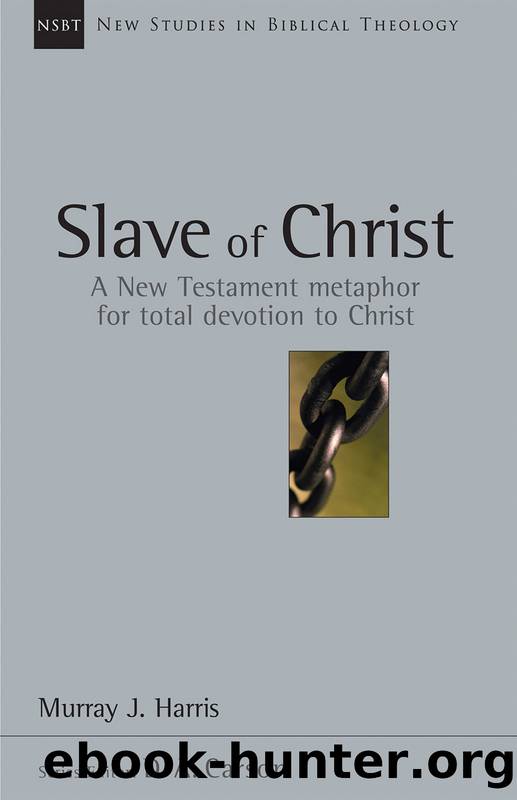Slave of Christ: A New Testament Metaphor for Total Devotion to Christ by Murray J. Harris

Author:Murray J. Harris
Language: eng
Format: epub
Tags: New Testament;slave;slavery;Jesus;devoted;devotion;lordship;free;freedom;ownership;privilege;Greco-Roman;New Studies in Biblical Theology;NSBT;Biblical theology;theology;Bible;Scripture;Christian;Christian theology;silver;silver series;D.A. Carson;DA Carson;
ISBN: 9780830871346
Publisher: InterVarsity Press
Published: 2018-11-15T00:00:00+00:00
Chapter Eight
âSlave of Christâ:
its significance in the
New Testament
Slave imagery and its origin
Slave imagery cannot be eradicated from the New Testament, and owes its origin to two sources: Greco-Roman society and Ancient Near Eastern custom, especially as seen in the Old Testament.
However much we moderns, living on the other side of the abolition of slavery, may be scandalized by the New Testament use of the image of slavery to depict one aspect of our ideal relationship to the Deity, we cannot eradicate such imagery from the New Testament without compromising its message. Not only is there slavery to sin or lust, which is condemned, but slavery to God or Christ, which is encouraged. In fact, terminology that is drawn from the sphere of slavery and is used in a figurative sense abounds in the New Testament (see Appendix 2). Moreover, God and his exalted Messiah are both given the titles kyrios (âSovereign Lordâ) and despotÄs (âAbsolute Lordâ), terms which themselves imply absolute sovereignty over slaves.1 Nor should we overlook the fact that the final picture the New Testament gives of the eternal state is one where âslavesâ (douloi) are completely devoted to the worship and service (latreusousin) of the Lord God and the Lamb (Rev. 22:3). The redeemed remain âslavesâ although their service is that of priests (cf. Rev. 1:6; 5:10; 20:6).2 According to the New Testament, spiritual slavery to Christ is an integral part of Christian discipleship, since the slaveâs Master is also his Teacher (John 13:13â14).
We have seen that one of the leading authorities on slavery in the ancient world, Professor Moses I. Finley (1976: 819), argued that among ancient cultures slavery as an institution essential to the production and lifestyle of a society was found only in classical Greece and classical Rome.3 These societies were based on slavery. Since slavery still flourished in first-century AD Greco-Roman society, it is a priori likely that the New Testament motif of spiritual slavery should have one of its roots in the contemporary practice and language of physical slavery. This a priori assumption proves to be factual, for we discovered numerous places where the New Testament description of spiritual servitude to God or Christ corresponds to the practice of slavery in Greco-Roman society.
But another sturdy root of New Testament usage is to be found in the Ancient Near East. E. Yamauchi (1966: 31) has convincingly demonstrated that âone has great difficulty in finding a culture in the Near East that does not have the âslave of Godâ motifâ.4 He reviews the evidence for the use of âslave of Godâ names under ten categories â Egyptian, Babylonian, Ugaritic, Mycenaean Greek, Phoenician, Old Testament, Aramaic, Hellenistic, Late Northwest Semitic, and Arabic â and concludes that âthe practice of designating oneself as the Slave of oneâs God has been maintained for at least 4000 years to this dayâ (35). In particular, all Israelites were regarded, or regarded themselves, as the âslavesâ of God the King on the analogy of the subjects of an earthly sovereign, who were regarded as the sovereignâs slaves whether or not they were in physical servitude.
Download
This site does not store any files on its server. We only index and link to content provided by other sites. Please contact the content providers to delete copyright contents if any and email us, we'll remove relevant links or contents immediately.
The Lost Art of Listening by Michael P. Nichols(7170)
Why I Am Not A Calvinist by Dr. Peter S. Ruckman(4051)
The Rosicrucians by Christopher McIntosh(3375)
Wicca: a guide for the solitary practitioner by Scott Cunningham(3046)
Signature in the Cell: DNA and the Evidence for Intelligent Design by Stephen C. Meyer(2880)
Real Sex by Lauren F. Winner(2875)
The Holy Spirit by Billy Graham(2783)
To Light a Sacred Flame by Silver RavenWolf(2681)
The End of Faith by Sam Harris(2637)
The Gnostic Gospels by Pagels Elaine(2403)
Waking Up by Sam Harris(2334)
Nine Parts of Desire by Geraldine Brooks(2283)
Jesus by Paul Johnson(2232)
Devil, The by Almond Philip C(2207)
The God delusion by Richard Dawkins(2193)
Heavens on Earth by Michael Shermer(2191)
Kundalini by Gopi Krishna(2094)
Chosen by God by R. C. Sproul(2058)
The Nature of Consciousness by Rupert Spira(1983)
